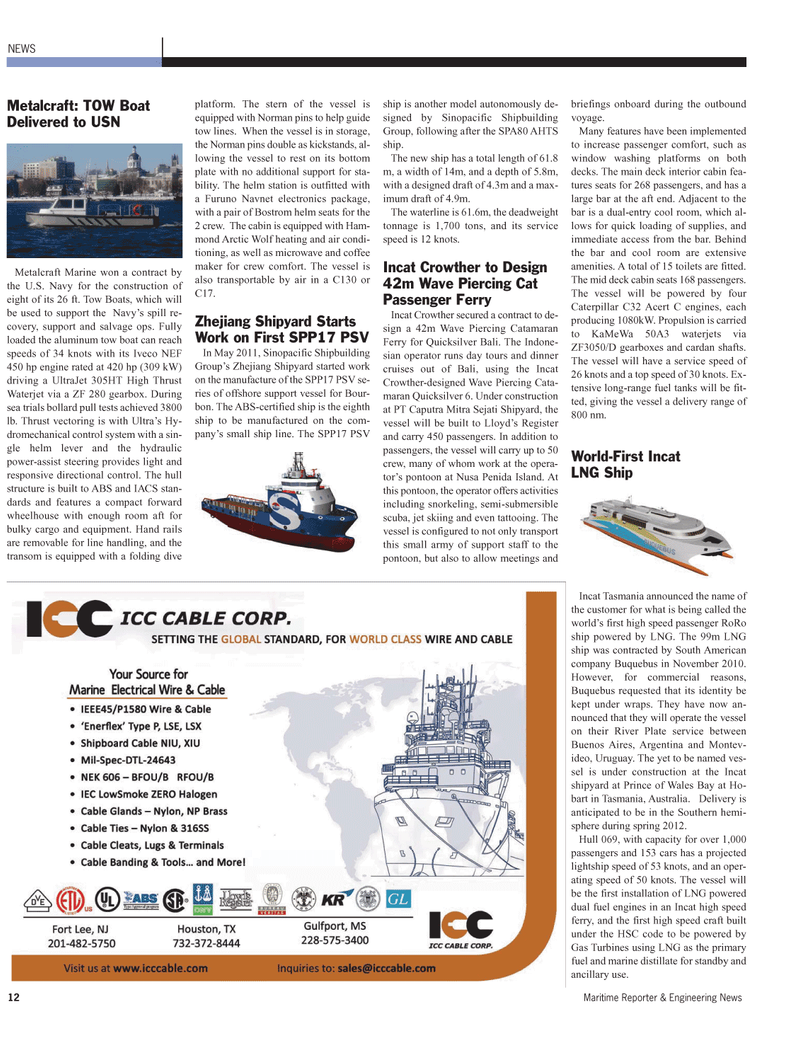
Page 12: of Maritime Reporter Magazine (June 2011)
Feature: Annual World Yearbook
Read this page in Pdf, Flash or Html5 edition of June 2011 Maritime Reporter Magazine
Metalcraft: TOW Boat Delivered to USN Metalcraft Marine won a contract by the U.S. Navy for the construction of eight of its 26 ft. Tow Boats, which will be used to support the Navys spill re- covery, support and salvage ops. Fully loaded the aluminum tow boat can reach speeds of 34 knots with its Iveco NEF 450 hp engine rated at 420 hp (309 kW)driving a UltraJet 305HT High Thrust Waterjet via a ZF 280 gearbox. During sea trials bollard pull tests achieved 3800 lb. Thrust vectoring is with Ultras Hy- dromechanical control system with a sin-gle helm lever and the hydraulic power-assist steering provides light and responsive directional control. The hull structure is built to ABS and IACS stan- dards and features a compact forward wheelhouse with enough room aft forbulky cargo and equipment. Hand rails are removable for line handling, and the transom is equipped with a folding dive platform. The stern of the vessel is equipped with Norman pins to help guidetow lines. When the vessel is in storage, the Norman pins double as kickstands, al-lowing the vessel to rest on its bottom plate with no additional support for sta-bility. The helm station is outfitted with a Furuno Navnet electronics package, with a pair of Bostrom helm seats for the2 crew. The cabin is equipped with Ham- mond Arctic Wolf heating and air condi- tioning, as well as microwave and coffee maker for crew comfort. The vessel is also transportable by air in a C130 orC17.Zhejiang Shipyard Starts Work on First SPP17 PSV In May 2011, Sinopacific Shipbuilding Groups Zhejiang Shipyard started work on the manufacture of the SPP17 PSV se- ries of offshore support vessel for Bour- bon. The ABS-certified ship is the eighth ship to be manufactured on the com- panys small ship line. The SPP17 PSV ship is another model autonomously de-signed by Sinopacific Shipbuilding Group, following after the SPA80 AHTS ship. The new ship has a total length of 61.8 m, a width of 14m, and a depth of 5.8m,with a designed draft of 4.3m and a max-imum draft of 4.9m. The waterline is 61.6m, the deadweight tonnage is 1,700 tons, and its servicespeed is 12 knots. Incat Crowther to Design 42m Wave Piercing Cat Passenger FerryIncat Crowther secured a contract to de- sign a 42m Wave Piercing Catamaran Ferry for Quicksilver Bali. The Indone- sian operator runs day tours and dinnercruises out of Bali, using the IncatCrowther-designed Wave Piercing Cata- maran Quicksilver 6. Under construction at PT Caputra Mitra Sejati Shipyard, the vessel will be built to Lloyds Register and carry 450 passengers. In addition topassengers, the vessel will carry up to 50 crew, many of whom work at the opera- tors pontoon at Nusa Penida Island. At this pontoon, the operator offers activities including snorkeling, semi-submersible scuba, jet skiing and even tattooing. The vessel is configured to not only transport this small army of support staff to the pontoon, but also to allow meetings and briefings onboard during the outbound voyage. Many features have been implemented to increase passenger comfort, such aswindow washing platforms on both decks. The main deck interior cabin fea- tures seats for 268 passengers, and has alarge bar at the aft end. Adjacent to the bar is a dual-entry cool room, which al-lows for quick loading of supplies, and immediate access from the bar. Behind the bar and cool room are extensive amenities. A total of 15 toilets are fitted. The mid deck cabin seats 168 passengers.The vessel will be powered by four Caterpillar C32 Acert C engines, each producing 1080kW. Propulsion is carried to KaMeWa 50A3 waterjets via ZF3050/D gearboxes and cardan shafts. The vessel will have a service speed of 26 knots and a top speed of 30 knots. Ex-tensive long-range fuel tanks will be fit- ted, giving the vessel a delivery range of 800 nm.World-First Incat LNG Ship Incat Tasmania announced the name of the customer for what is being called the worlds first high speed passenger RoRo ship powered by LNG. The 99m LNG ship was contracted by South American company Buquebus in November 2010. However, for commercial reasons, Buquebus requested that its identity be kept under wraps. They have now an- nounced that they will operate the vessel on their River Plate service between Buenos Aires, Argentina and Montev- ideo, Uruguay. The yet to be named ves- sel is under construction at the Incatshipyard at Prince of Wales Bay at Ho- bart in Tasmania, Australia. Delivery is anticipated to be in the Southern hemi-sphere during spring 2012. Hull 069, with capacity for over 1,000 passengers and 153 cars has a projectedlightship speed of 53 knots, and an oper- ating speed of 50 knots. The vessel will be the first installation of LNG powered dual fuel engines in an Incat high speedferry, and the first high speed craft built under the HSC code to be powered by Gas Turbines using LNG as the primary fuel and marine distillate for standby andancillary use. 12Maritime Reporter & Engineering News NEWS

 11
11

 13
13
